1.2.1-2 Anatomy of an Autopsy and Time of Death
1/16
There's no tags or description
Looks like no tags are added yet.
Name | Mastery | Learn | Test | Matching | Spaced |
|---|
No study sessions yet.
17 Terms
What is a morgue?
A place where the bodies of dead persons are kept temporarily pending identification or release for burial or autopsy.
What is an autopsy?
A postmortem evaluation to determine cause of death.
What are the key components of an autopsy?
1.The brain is checked for signs of injury. It is then removed from the skull, weighed, and examined.
2.Various saws, scissors, needles, and other tools are available to complete the internal examination as well as stitch up the body after the autopsy is concluded.
3.The first cut extends from each shoulder to the center of the chest and down the center of the body. This is known as a "Y incision". Organs are examined in place and are then removed to be examined and weighed.
4.A description of the body is recorded (hair color, eye color, sex, etc.) and it is measured and weighed. Evidence of external injury is noted.
5.Photographs are taken to document injury, features of identification, and/or the state of decomposition.
6.The stomach contents are examined. The identity and degree of digestion of foods (or other items such as pills) is determined. This analysis may help determine the time of death.
7.Samples of blood, urine, and tissues are collected and sent away for additional testing to help determine identity and/or cause of death.
8.Features of identity are noted - including tattoos, birthmarks, or other identifying marks. ID by personal documents (such as a license) or friends/relatives are also noted.
What is grossing?
Visually inspecting the organs or tissues and describing what is seen is referred to as “grossing” or gross examination. This view provides clues even before microscopic examination is completed.
Autopsy Terminology
cause of death-The specific injury, trauma, or disease that directly caused the victim's death.
mechanism of death-What happens physiologically (inside the body) to result in death.
Manner of Death-The circumstances that result in death, which are designated as natural or unnatural.
Ex- Cause-Gunshot wound,Manner-Homicide,Mechanism-Extreme blood loss
How are the organs in the human body classified?
They are classified into systems which are a group of organs in a body that work together to perform a specific function.
Do these systems work hand in hand?
Problems with one body system can have minor, moderate, or very serious effects on other systems.
Terminology-Time of Death
Physiological Time of Death-The time when the decedent’s vital functions actually ceased.
Estimated Time of Death-The time the medical examiner estimates that the death occurred.
Legal Time of Death-The time of death recorded on the death certificate; based on when the body was found or physically pronounced dead.
Changes after Death-Temperature
Immediately after you die your body starts Cooling and it is estimated that you lose 1.5 degrees per hour until you reach the temperature of the room. But there are certain factors that may change this rate. If you die at room temperature it typically takes 24 hours to reach the surrounding temperature.
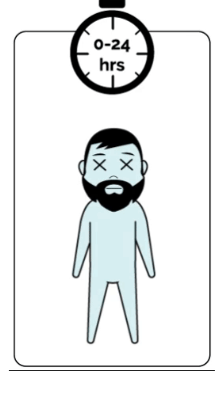
Change after Death-Clouding of Corneas
Within the first several hours after death, the corneas, which are usually the clear parts of the eyes, become milky or cloudy.
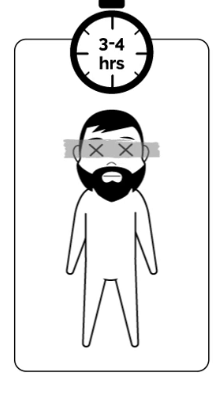
Change after Death-Rigor Mortis
After the body stops functioning, the muscles contract and stiffen. This change is called rigor mortis and typically begins 2-4 hours after death. Rigor is first observed in the head and neck and then moves to the arms and legs. Full rigor is present throughout the body in 8–12 hours and “fixes” the body in the position assumed at death. After about 36–48 hours, rigor fades as decomposition begins.
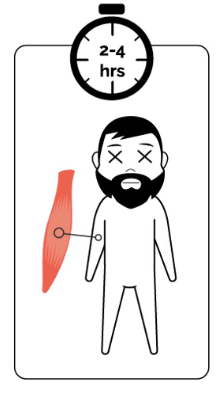
Change after Death-Livor Mortis
Blood settles or collects on the parts of the body facing the ground. The bluish color seen on the skin where this blood pools is called livor mortis or lividity. Early signs of this blood settling occur within the first 2 hours of death. Full signs occur within five hours and lividity is fixed in place in 8-12 hours.
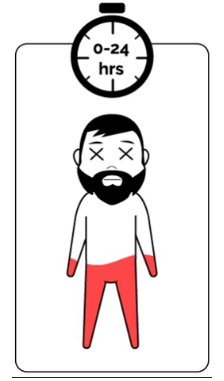
Change after Death-Decomposition
Decomposition begins 36-48 hours after death. The body turns greenish in color and may swell or bloat as bacteria break down tissue and release gas. This decomposition, or putrefaction, also comes with a nasty smell.
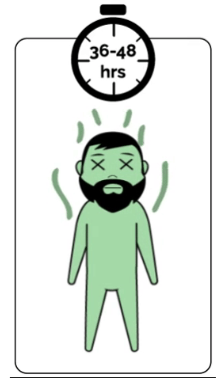
Change after Death-Insect Activity
Insect activity can also provide clues about how long a person has been dead. The presence of eggs, larva, or full-grown bugs provide a timestamp for how long the body has been decaying.
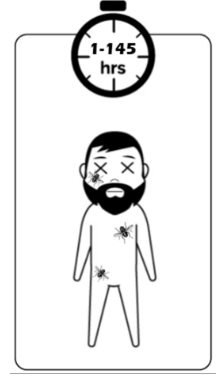
Celsius vs. Fahrenheit
The equation to convert Celsius to Fahrenheit is:
(°C × 1.8) + 32 = °F
For example, to determine the Fahrenheit equivalent to 0 °C:
(0° × 1.8) + 32 = 32 °F
(20 °C × 1.8) + 32 =
36 + 32 =
68 °F
(50 °C x 1.8) + 32 =
90 + 32 =
122 °F
Glaister equation
98.4-rectal temperature/1.5=apx hours since death
Timeline of Development for Blue Bottle Flies
Day 1-Blue Bottle Fly Egg Cases (10x magnification)
Within hours of death, flies appear on the corpse and lay eggs. They can lay around 200-300 eggs which are roughly 1.5 mm x 0.4 mm in size.
Day 2-Larvae: First Instar (10x magnification)
Within 24 hours of being laid, the eggs will hatch and larvae (also known as maggots) emerge. These larvae will go through several stages as they grow into adult flies. The first stage is called the First Instar and they are roughly 2 mm long at this stage and will grow to approximately 5 mm.
The pointed end is where the developing mouthparts are located. The rounded or blunt end is where the spiracles, the structure through which the larvae respire, are developing. The larvae remain together as a maggot mass and won't move individually until they reach the pupa phase.
Day 3-Larvae: Second Instar (10x magnification)
In roughly 24-28 hours the First Instar larvae molt, shedding their outer covering (exoskeleton). The larvae that emerge are in the second stage or Second Instar. They grow from about 5 mm to 10 mm. The Second Instar larvae continue to remain as a maggot mass.
Day 4-Larvae: Third Instar (10x magnification)
Day 2-3: At approximately 47-51 hours, the Second Instar larvae molt and Third Instar larvae emerge. These larvae will grow to be about 15-20 mm in length. The Third Instar larvae continue to remain as a maggot mass.
Day 5-Pupae (10x magnification)
Day 5: After about 132 hours, the larvae undergo their final molt to become pupa. The pupae are approximately 20 mm in length. Their exoskeleton hardens and turns darker in color. They move individually and may migrate away from the corpse to complete their transformation into adult flies, often burrowing into the ground.
Day 6-Adult Fly
Day 6: After about 145 hours, the adult fly emerges and can fly within a few hours to continue the life cycle by mating and females laying new eggs.